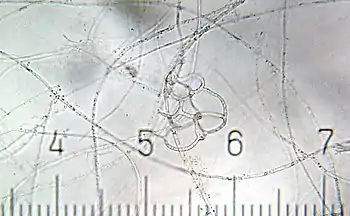Orbiliaceae
The Orbiliaceae are a family of saprobic sac fungi in the order Orbiliales. The family, first described by John Axel Nannfeldt in 1932, contains 288 species in 12 genera.[1] Members of this family have a widespread distribution, but are more prevalent in temperate regions.[2] Some species in the Orbiliaceae are carnivorous fungi, and have evolved a number of specialized mechanisms to trap nematodes.
| Orbiliaceae | |
|---|---|
_Fr_343795.jpg.webp) | |
| Orbilia xanthostigma | |
| Scientific classification | |
| Kingdom: | Fungi |
| Division: | Ascomycota |
| Class: | Orbiliomycetes |
| Order: | Orbiliales |
| Family: | Orbiliaceae Nannf. (1932) |
| Type genus | |
| Orbilia Fr. (1836) | |
| Genera | |
|
Arthrobotrys | |

Description
Orbiliaceae do not have stromata, dense structural tissue that produces fruit bodies. They have small disc-shaped apothecia, that are typically convex, brightly colored or translucent.[2] Their ascospores are small (typically less than 10 x 1 μm), hyaline, and have an oval or ellipsoidal shape.[3] Species are usually found in wood on both wet and dry habitats.[2] Anamorph species are hyphomycetous.[4]
Nematophagy
This family is well known for its many nematophagous species.[5] Shortly after coming into contact with its prey, fungal mycelia penetrate the nematode and spontaneously differentiate into functional structures, known as traps, which will ultimately digest the nematode's internal contents.[6] There are 5 types of trap mechanisms recognized in this family:[6][7][8][9]
- Adhesive network: the most common trap, formed by hyphal outgrowths that recurve into themselves to form nematode-trapping loops.
- Adhesive knob: a roughly spherical cell, attached to the hyphae either directly or on an erect stalk. Adhesive knobs are typically closely spaced along a section of hyphae.
- Nonconstricting rings: always found with the adhesive network traps, and formed from thickening hyphae that curve and fuse to the supporting stalk.
- Adhesive column: a layer of cells on a hyphae with an adhesive surface.
- Constricting rings: these are rings of hyphae that swell rapidly inwards upon contact with the nematode, quickly (in 1–2 seconds) "lassoing" the victim.
Genera
According to the most recent classification of Ascomycota,[10] the Orbiliaceae contain only two (teleomorph) genera, the Hyalorbilia and the Orbilia. Hyalorbilia is distinguished from Orbilia by having asci without a stalk that arise from croziers, a hemispherical to broadly conical, thin-walled apex, asci and paraphyses in a gelatinous matrix, and an ectal excipulum (the outer surface of a cup-like apothecium) of horizontal textura prismatica.[11][12]
Anamorph genera of the Orbiliaceae include Anguillospora,[13] Arthrobotrys,[14] Dactylella,[15] Dactylellina, Dicranidion,[16] Drechslerella, Helicoön,[17] Monacrosporium, and Trinacrium. It has been suggested that the anamorph specialization illustrates convergent evolution occurring among mycelial fungi in aquatic and low-nitrogen habitats.[18] This hypothesis has been borne out by recent phylogenetic and morphological studies.[19]
In 2007, a new species was described from southwestern China with morphological features intermediate between Orbilia and Hyalorbilia. This species, named Pseudorbilia bipolaris Y. Zhang, Z.F. Yu, H.O. Baral & K.Q. Zhang, was placed into its own genus in the Orbiliaceae to accommodate its distinctive features.[20]
References
- Kirk MP, Cannon PF, Minter DW, Stalpers JA (2008). Dictionary of the Fungi (10th ed.). Wallingford: CABI. p. 485. ISBN 978-0-85199-826-8.
- Cannon PF, Kirk PM (2007). Fungal Families of the World. Wallingford: CABI. p. 251. ISBN 978-0-85199-827-5.
- Blackwell M, Alexopoulos CJ, Mims CW (1996). Introductory Mycology. New York: Wiley. ISBN 0-471-52229-5.
- Bisby GR, Ainsworth GC, Kirk PM, Aptroot A (2001). Ainsworth & Bisby's Dictionary of the Fungi. Oxon: CAB International. p. 369. ISBN 0-85199-377-X.
- Pfister DH. (1997). Castor, pollux and life histories of fungi. Mycologia 89(1): 1-23.
- Barron, George L. (1977). The Nematode-destroying Fungi. Guelph: Canadian Biological Publications. ISBN 0-920370-00-4.
- Yang Y, Yang E, An Z, Liu X (2007). "Evolution of nematode-trapping cells of predatory fungi of the Orbiliaceae based on evidence from rRNA-encoding DNA and multiprotein sequences". Proc. Natl. Acad. Sci. U.S.A. 104 (20): 8379–84. doi:10.1073/pnas.0702770104. PMC 1895958. PMID 17494736."www.pnas.org" (PDF). Retrieved 2008-12-30.
- Drechsler C. (1937). Mycologia 29: 447–552.
- Stirling GR (1991). Biological control of plant parasitic nematodes. Wallingford, UK: C.A.B. International. ISBN 0-85198-703-6.
- "Outline of Ascomycota - 2007". Retrieved 2008-12-25.
- Baral HO. (1994). Comments on "Outline of the ascomycetes – 1993". Systema Ascomycetum 13: 113-128.
- Wu ML, Su YC, Baral HO, Liang SH. (2007). Two new species of Hyalorbilia from Taiwan. Fungal Diversity 25: 233–44.
- Webster J, Descals E. (1979). The teleomorphs of water-borne Hyphomycetes from fresh water. pp. 419–51. In: The Whole Fungus. Ed., Bryce Kendrick. National Museum of Natural Sciences, National Museums of Canada, Ottawa, Canada.
- Pfister DH. (1994). Orbiliafimicola, a nematophagous discomycete and its Arthrobotrys anamorph. Mycologia 86: 451–53.
- Thakur S, Zachariah K. 1989. Response of the fungus Dactylella rhopalota to bacteria. Plants & Soil 120: 87–93.
- Korf RP. (1992). A preliminary discomycete flora of Macronesia: Part 8, Orbiliaceae. Mycotaxon 45: 503–10.
- Pfister DH. (1995). Helicoon sessile, the anamorph of Orbilia luteorubella. Inoculum 46: 34 (Newsletter of Mycological Society of America).
- Moore D, Rayner AD, Brasier CM (1987). Evolutionary Biology of the Fungi: symposium of the British Mycological Society held at the University of Bristol, April 1986. Cambridge, UK: Cambridge University Press. pp. 191–201. ISBN 0-521-33050-5.
- Li Y, Hyde KD, Jeewon R, Cai L, Vijaykrishna D, Zhang K (2005). "Phylogenetics and evolution of nematode-trapping fungi (Orbiliales) estimated from nuclear and protein coding genes" (PDF). Mycologia. 97 (5): 1034–46. doi:10.3852/mycologia.97.5.1034. hdl:10722/53351. PMID 16596955.
- Pseudorbilia gen. nov. (Orbiliaceae) from Yunnan, China. Fungal Diversity PDF
External links
| Wikimedia Commons has media related to Orbiliaceae. |
| Wikispecies has information related to Orbiliaceae. |
